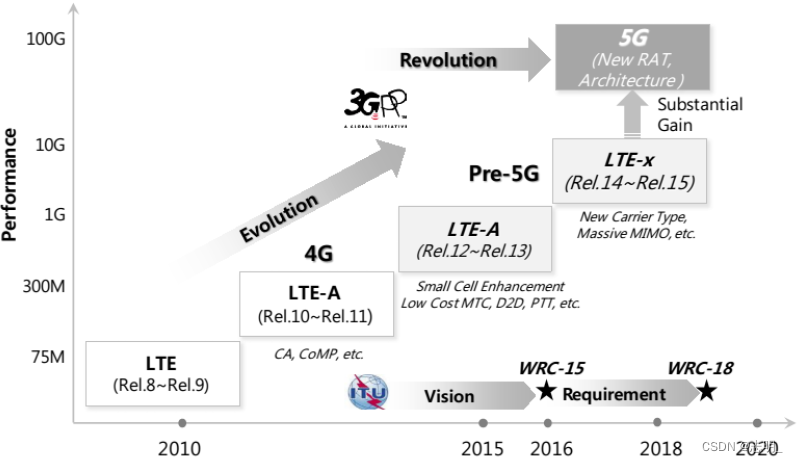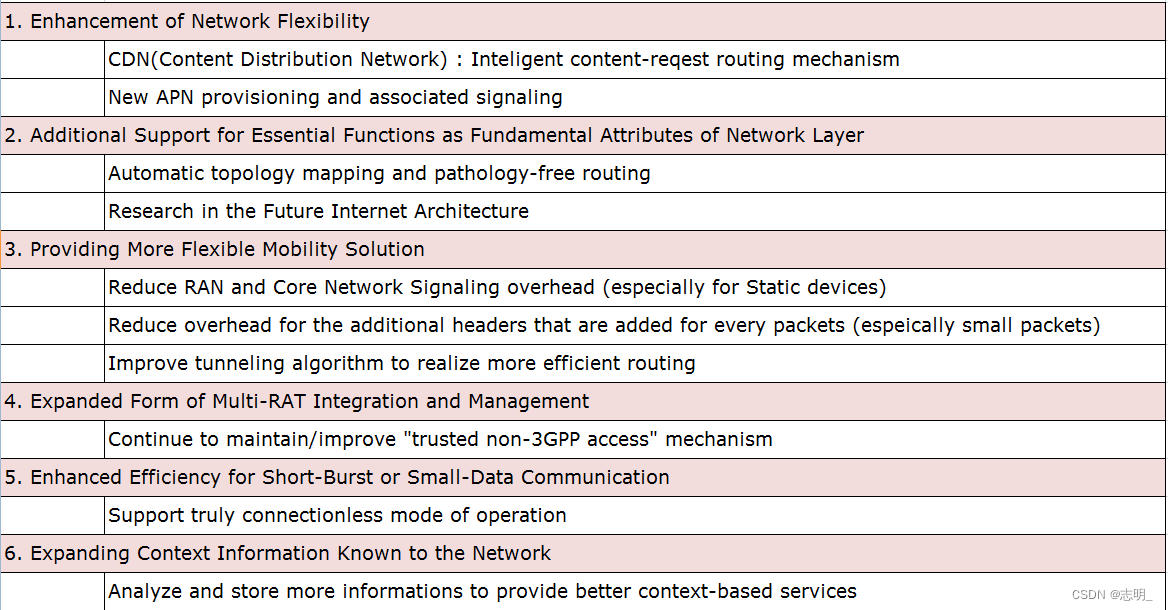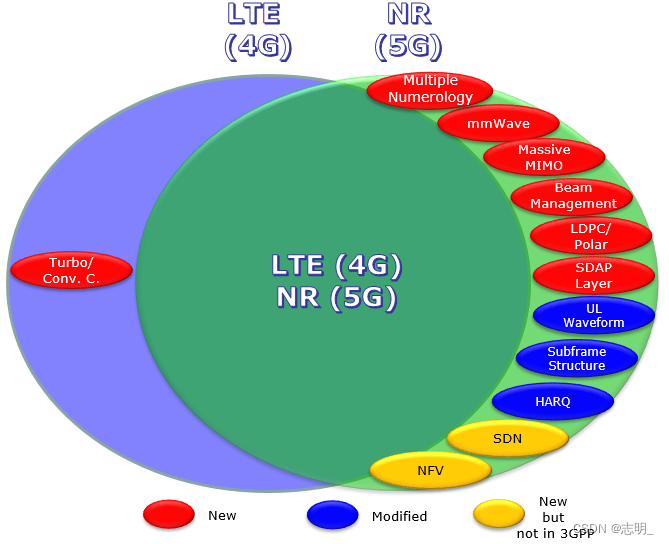目录
一、5G/NR
1、 快速参考(Quick Reference)
2、5G Success
3、5G Challenges
4、Qualcomm Videos
二、PHY and Protocol
1、Frame Structure
2、Numerology
3、Waveform
4、Frequency Band
5、BWP
6、Synchronization
7、Beam Management
8、CSI Framework
9、Channel Mapping
10、CORESET
11、DCI
12、SLIV
13、UCI/PUCCH
14、Reference Signal
15、MAC
16、RLC
17、PDCP
18、SS Block
19、Scheduling
20、MIB / SIB
21、RACH
22、RRC Overview
23、RrcReconfiguration
24、NSA/ENDC
25、SA/Initial Attach
26、UE Capability
27、Paging
28、 Power Control
29、MIMO Config. DL
30、MIMO Config. UL
三、NAS / Core
1、Registration
2、Network Slice
3、Core Architecture
四、Misc.
1、Field Test
2、OTA(Over The Air)
3、Release 16
4、Release 17
5、Massive MIMO ?
6、WhyMassiveMIMO ?
7、Propagation Model
一、5G/NR
1、 快速参考(Quick Reference)
1) Pre 5G Chronicles
a、 What has been done/talked before the realization of 5G ?
b、 Time Table/Milestones
2) 4G to 5G Evolution
3) 4G vs 5G
4) Post-deployment Evolution (Cell Coverage, Test Report)
5) Post-deployment Challenges
6) 5G Definitions
7) 5G Indication : upperLayerIndication
8) 5GMM
9) 5GSM
10)5QI
11) 5G Release 16 Highlights
12) 5G Release 17 Highlights
13) 5G Release 18 Highlights
14) 5WWC/ATSSS
15) Acronyms
16) Agreed Items
17) AI/ML (Aritificial Intelligence / Machine Learning)
18) AMF
19) Antenna Ports
20) Articles on 5G (Before Deployment)
21) ATSSS/5WWC
22) Beam Failure Recovery
23) Beam Forming
24) Beam Management
25) BWP(Bandwidth Part)
26) BWP Switching
27) Call Process : SA Initial Attach
28) Carrier Aggregation
29) Carrier Bandwidth Part (BWP)
30) Cell Search / SIB1 Decoding
31) Cell Selection
32) Cell Selection Criteria
33) CBG(Code Block Group)
34) Challenges
35) Channel Coding
36) Channel Structure / Channel Mapping
37) Common Search Space(Type 0 PDCCH, RMSI-PDCCH-Config)
38) Common Search Space(Type 1 PDCCH)
39) CoMP
40) ConfiguredScheduling/SPS
41) Converged Connectivity - ATSSS/5WWC
42) Core - Network Interfaces
43) Core - AMF
44) Core - NRF
45) Core - N22 - NSSF
46) Core - SMF
47) Core - UDM
48) Core - N1 Interface
49) Core - N26 Interface
50) Core - N12,N13 - AMF,AUSF,UDM - Authentication
51) Core - N8 - Registration
52) Core - NGAP
53) Core - SCTP
51) Core - GTP
52) CORESET(Parameters, Example)
53) CORESET 0/SIB 1 decoding
54) CPRI
55) CSI Framework
56) CSI Report
57) CSI RS
58) CSI RS Codebook
59) CU/DU Separation
60) Current Activities (Who is doing what ?)
61) DCI
62) Deployment Scenario
63) DFT-s-OFDM
64) DNN / LADN
65) Downlink Preamption
66) DSS (Dynamic Spectrum Sharing)
67) eCPRI
68) EIRP
69) Enhanced Massive MIMO
70) Event and Forum
71) Field Test
72) Frame Structure
73) Frame Structure : Candidate
74) Frequency Domain Position/Resource Block Indexing
75) FR(Frequency Range) / Operating Band
76) FRC (Fixed Reference Channel)
77) General News
78) GSCN
79) HARQ(ACK/NACK)
80) HARQ-ACK Codebook
81) History of 5G (5G before 3GPP)
a、 Activities
b、 Articles/New
c、 Propagation Model
82) IAB (Integraded Access / Backhaul)
83) IP Allocation
84) K0,K1,K2,N1,N2
85) LADN / DNN
86) LTE Interworking (NSA : Non StandAlone)
87) MAC : Overview
88) MAC CE
89) MAC CE : Buffer Status Report
90) MAC CE : C-RNTI
91) MAC CE : Contention Resolution
92) MAC CE : SCell Activation/Deactivation
93) MAC CE : TCI State Indication for UE-specific PDCCH MAC CE
94) MAC CE : TCI States Activation/Deactivation for UE-specific PDSCH MAC CE
95) MAC CE : Timing Advance
96) Massive MIMO : Introduction/Definition
97) Massive MIMO : Motivation (Why We Need it ?)
98) Massive MIMO : FD-MIMO
99) Massive MIMO : MU-MIMO
100) Massive MIMO : Channel Model
a、 Scaling up MIMO : Opportunities and Challenges with Very Large Arrays
b、 Massive MIMO and Small Cells : Improving Energy Efficiency by Optimal Soft-Cell Coordination
c、 Multi-Layer Precoding for Full-Dimensional Massive MIMO Systems
d、 MU-MIMO Channel Estimation
101) Massive MIMO : Reciever Model
102) Massive MIMO : in 3GPP
103) Massive MIMO : Technical Challenges/Further Studies
104) Matlab Toolbox : 5G Library : SS/PBCH Block
105) Matlab Toolbox : 5G Library : PDSCH/DMRS
106) Matlab Toolbox : 5G Library : PUCCH Format 0
107) Matlab Toolbox : 5G Library : PUCCH Format 1
108) Matlab Toolbox : 5G Library : Slot Structure : Downlink / All Channels
109) Matlab Toolbox : 5G Library : Slot Structure : Uplink
110) Matlab Toolbox : 5G Library : PRACH / FR2 (120 Khz)
111) Matlab Toolbox : 5G Library : SRS (120 Khz)
112) Matlab Toolbox : 5G Library : CSI-RS
113) Matlab Toolbox : 5G Library : CSI Codebook
114) Matlab Toolbox : 5G Library : Spectrogram : Downlink (SSB, PDCCH,PDSCH,CSI-RS)
115) Matlab Toolbox : 5G Library : NR Synchronization in TDL Channel
116) Matlab Toobox : 5G Library : NR Synchronization in CDL Channel
117) Max Throughput Estimation
118) MCS/TBS/Code Rate
119) Measurement
120) MIB / SIB
121) Mini Slot
122) MIMO : Downlink
123) MIMO : Uplink
124) mmWave
125) mmWave Antenna on UE
126) N1 mode / S1 mode
127) N1 Interface
128) N2 Interface
129) N8 Interface
130) N22 Interface
131) N26 Interface
132) NAS : 5GMM
133) NAS : 5GSM
134) NAS : Registration / Reject / Reject Cause
135) NAS : PDU Session Establishment
136) NAS : Service Setup
137) NAS : UAC (Unified Access Control)
138) Network Architecture / Network Interfaces
139) Network Architecture / Network Interface - N1
140) Network Slicing
141) New Waveform Cadidate : Introduction
142) New Waveform Candidate : FBMC
143) New Waveform Candidate : f-OFDM
144) New Waveform Candidate : GFDM
145) New Waveform Candidate : UFMC
146) New Waveform Candidate : DFT-s-OFDM
147) NGAP
148) NPN(Non-Public Network)
149) NRF
150) NR Indication : upperLayerIndication
151) NR-Light/RedCap
152) NRU (NR Unlicensed)
153) NTN (Non Terestrial Network)
154) Numerology
155) NWDAF
156) OpenRAN - Overview
157) OpenRAN - Architecture
158) OpenRAN - Where to Split
159) OSI (Other SI) Scheduling
160) OTA(Over The Air) Measurement
161) Paging
162) Parameter Structure : PHY
163) PBCH
164) PBCH DMRS
165) PBCH Decoding Process
166) PCO (Protocol Configuration Option)
167) PDCCH
168) PDCCH Common
169) PDSCH
170) PDSCH AggregationFactor
171) PDSCH DMRS
172) PDSCH PTRS
173) PDSCH/PUSCH Mapping Type (Type A, Type B)
174) PDCP
175) PDU Session Establishment (IP Allocation, QoS)
176) Physical Layer : Beam Management
177) Physical Layer : Frame Structure
178) Physical Layer : Numerology
179) Physical Layer : Pseudo Random Sequence
180) Physical Layer : Reference Signals
181) Physical Layer : SS Block, SS/PBCH
182) Physical Layer : Synchronization
183) Physical Layer : Timing Units
184) Physical Layer : Uplink Transmission Timing
185) Physical Layer : Waveform
186) Physical Layer Signal : PBCH DMRS
187) Physical Layer Signal : PDSCH DMRS
188) Physical Layer Signal : PSS (Primary Synchronization Signal)
189) Physical Layer Signal : SSS (Secondary Synchronization Signal)
190) Pyhsical Layer Channel : PBCH
191) Physical Layer Channel : PDCCH
192) Physical Layer Channel : PDSCH
193) Physical Layer Channel : PUCCH
194) Physical Layer Channel : PUSCH
195) PointA, OffsetToPointA
196) Positioning
197) Power Control
198) Power Definition / Measurement (RSRP, RSRQ, SINR)
199) Power Saving
200) Pre Trial : Overview
a、 Pre Trial : Frame Structure
b、 Pre Trial : Matlab : Frame Structure / Resource Element Mapping
c、 Pre Trial : Physical Signal : PSS
d、 Pre Trial : Physical Signal : SSS
e、 Pre Trial : Physical Signal : ESS
f、 Pre Trial : Physical Signal : BRS
g、 Pre Trial : Physical Signal : BRRS
h、 Pre Trial : Pseudo Random Sequence
i、 Pre Trial : Basic Procedure : Power On Procedure
j、 Pre Trial : RRC : MIB/SIB
k、 Pre Trial : RACH
201) Private Network (LTE)
202) Private Network/NPN(Non-Public Network) (NR)
203) Pseudo Random Sequence
204) Propagation Model
205) Protocol Configuration Option(PCO)
206) PSS (Primary Synchronization Signal)
207) PTRS - PDSCH
208) PUCCH
209) PUSCH AggregationFactor
210) PUSCH Channel Coding and Transmssion Process
211) PUSCH DMRS
212) PUSCH Precoding / Transmission Mode (Codebook vs Non-Codebook based)/UL Transmission Scheme
213) QCL (Quasi Co Location)/TCI
214) QoS / QFI / QRI
215) RACH
216) RACH-2 Step
217) Radio Protocol Architecture
218) RAN Architecture
219) RateMatchPattern
220) Reference Signal
221) RedCap/NR-Light
222) Registration - RegistrationRequest / RegistrationAccept
223) Release 16 Highlights
224) Release 17 Highlights
225) Release 18 Highlights
226) Resource Allocation (Time [K0,K1,K2])
227) Resource Allocation Type (RA Type 0, RA Type 1)
228) Resource Allocation Units (RE, REG, REG Bundle, CCE, Aggregation Level, CORESET)
229) Resource Allocation - Applicable Time Domain Resource Allocation
230) Resource Block Indexing/Frequency Domain Position
231) Resource Grid
232) RLC
233) RMSI-PDCCH-Config/Type 0 PDCCH Common Search Space
234) RNTI
235) RRC CONNECTED <-> INACTIVE Transition
236) RRC Constraints
237) RRC Overview
238) RRC INACTIVE
239) RRC Reconfiguration
240) SCG-Failure
241) Scheduling : Overview
242) Scheduling : Dynamic / L2 Scheduling
243) SDL (Supplimentary Downlink)
244) Security for 5G
245) Security for Cellular Ingeneral
246) Search Space
247) Self-Contained Slot
248) Service Setup
249) SIB 1 decoding
250) Sidelink
251) SLIV
252) Slot Configuration
253) Slot Format Combination
254) SMF
255) Software Defined Network (SDN) : Overview
256) Software Defined Network (SDN) : OpenFlow
257) Split Bearer
258) SPS/ConfiguredScheduling
259) SR(Scheduling Request)
260) SRB(Signaling Radio Bearer)
261) SRS/Antenna Switching
262) SS Block, SS/PBCH
263) SSS (Secondary Synchronization Signal)
264) SUL(Supplementary Uplink)
265) Synchronization
266) TBS Determination
267) TCI/QCL
268) TDD DL/UL Common Configuration(TDD-UL-DL-ConfigCommon)
269) TDD DL/UL Dedicated Configuration(TDD-UL-DL-ConfigDedicated)
270) Technical Challenges
271) Tech Viedos for 5G
272) Test : Equipment : Concept and Idea
273) Test : RF Connection Method
274) Throughput Estimation
275) Time Table (MileStones to 5G)
276) Timing Advance
277) Timing Units
278) TRS (Tracking Reference Signal)
279) Type 0 PDCCH Common Search Space/RMSI-PDCCH-Config
280) Type 1 PDCCH Common Search Space
281) Two Step RACH (2 step RACH)
282) UAC (Unified Access Control)
283) UCI (Uplink Control Information)
284) UDM
285) UE Assistance Information
286) UE Capability
287) UE ID
288) UL Transmission Scheme / PUSCH Precoding / Transmission Mode (Codebook vs Non-Codebook based)
289) URLLC
290) VoNR
291) Wake Up Signal(WUS)
292) Waveform
293) WhitePapers and Forums/Summits (Before 5G Deployment)
294) WUS (Wake Up Signal)
一、5G/NR
1、 快速参考(Quick Reference)
2) 4G to 5G Evolution
● 4G到5G的迁移/演进(Migration/Evolution)
如果您刚刚阅读了5G定义页面中介绍的所有5G初始定义(initial definition)/需求文件。你可能会认为“这太好了,无法实现(realize)。说起来很容易,但几乎不可能实现(implement)。”的确,我们不可能在一夜之间(overnight)一步到位地实现所有这些要求。但当你回顾无线通信的历史(实际上actually是任何技术)时,大多数新技术都是从我们现在拥有的开始,并逐渐(gradually )发展(evolve),最终(eventually)实现我们认为不可能实现的目标。
5G将以类似的方式实现,尽管许多5G文件说“5G应该走与我们以前看到的截然不同的(drastically different)发展道路(evolution path)”。我们已经看到一些在当前技术(4G)中被视为非常先进的功能,但将成为5G的一种基本功能。我认为下面的插图让我们对进化路径有了很好的了解。如果你对5G技术细节感兴趣,但由于没有既定的(established)标准/规范而不知道该怎么办,那么沿着解决方案的道路遵循当前的3GPP规范可能是一个很好的起点。
下图(Following figure)来自SK Telecom 5G WhitePaper(强烈建议recommed阅读完整文件)。

以下来自白皮书:4G Americas关于5G需求和解决方案(Requirements and Solution)的建议(recommendation)。同样,请先阅读完整的文档,并根据需要使用此表刷新内存。

● 3GPP 5G Workshop - Sep 2015
我认为没有太多严肃的(serious)讨论。许多演示文稿(presentation),但大多与谷歌搜索和各种公司发布的一些白皮书的水平相似。但我认为这是有意义的(meaningful),因为这是3GPP umberella下的第一次技术集会(gathering)。(请参阅here查看所有演示presentation)
● Main Study Topcis in Rel 13
关于正式(official)介绍,请参考(Refer to)第13版(Release)中的3GPP Evolution。此外,我发现Erricson在YouTube上发布(post)了相当不错的介绍:Tech Talk shows benefits of LTE Release 13。自2016年4月起,3GPP初始(Initial)文档已发布(release)并可从3GPP站点获得。Rel 13中的新功能将在LTE高级专业版概述页面(LTE Advanced Pro - Overview page)中跟进(follow up)。
以下是我的简介。
<未授权频谱中的LTE( LTE in unlicensed spectrum)>
即使没有规格(specification),这个领域已经讨论了很长时间,一些芯片组供应商(chipset vendor)已经处于测试阶段(at the stage of )几个月了(2015年4月)。
这是一种特殊的载波聚合(Carrier Aggregation),其基本思想是使用许可的(licensed)LTE频谱(spectrum)作为PCC,使用未许可的(unlicensed)频谱作为SCC。到目前为止,用于此目的的最常见的未授权频谱是5GHz的WLAN频谱,但理论上(theoretically)我们可以将其扩展(extend)到任何频谱。
有关更多详细信息,请参阅RP-150055。
<载波聚合增强(Carrier Aggregation enhancements)>
截至目前(Rel 12),我们可以聚合(aggregate)的最大载波(carrier)数量为5。这项活动的主要项目是将聚合载波(aggregated carrier)的数量扩展到32个。2015年3月31日,已经有一个实现9 CC CA的演示(demo)。
网络运营商(network operator)KT和移动制造商(manufacturer)SamSung为TDD 9 CC CA做了演示(Netmanias Interview with KT at MWC 2015: KT’s demonstrations of LTE TDD (9-carrier CA, LTE-UL/DL CA and triple mode femto)
详见RP-142286。
<针对机器类型通信(MTC)的LTE增强功能(LTE enhancements for Machine-Type Communications (MTC))>
该活动的主要目标(objective)是以非常低的成本实现(implement)低吞吐量设备。我的总结(summary)见MTC页面,更多细节见RP-141865。
我认为5G很可能(highly likely)也会采用(adopt)这一领域开发的许多技术。
<D2D的增强功能(Enhancements for D2D)>
D2D自Rel 12以来一直在研究(investigate),基本概念在我的D2D/Prosec and D2D/Radio Protocol页面中进行了总结(summarize)。本活动的目的(objective)是对现有主题进行一些改进(enhancement)。
详见RP-1421311。
<仰角波束形成/全尺寸MIMO(Elevation Beamforming / Full-Dimension MIM)>
本活动的主要目标是定义增加下行链路(downlink)天线数量(最大64个)的技术,并将这些天线排列(arrange)在二维网格(2 dimensional grid)中。
我认为这里开发的技术很可能(likely)会被5G所采用。详见RP-141831。
<增强型多用户传输技术(Enhanced multi-user transmission techniques)>
在这项活动中,将研究实现MU-MIMO的技术追求(techniquest),该MU-MIMO对小区内干扰是固有的,并且即使在正交性得不到保证的情况下也可以工作。
我认为这项技术与FD-MIMO相结合(in combination with)将是5G中非常重要的技术组成部分。详见RP-142315。
<室内定位(Indoor positioning)>
详见RP-141102。
<单小区点对多点(SC-PTM)(Single-cell Point-to-Multipoint (SC-PTM))>
详见RP-142205。
● 3GPP TSG RAN WG1 Meeting #84bis - Apr 2016
从这次会议的结果(outcome)来看,我开始感觉到5G在3GPP中的发展非常认真。你会在这里得到很多以TDocs形式出现的5G相关材料。
● 3GPP TSG RAN WG1 Meeting #85 - May 2016
我在这里看到的5G/NR TDocs没有#84bis那么多,但在某些主题上,我从这次会议中得到了更多的澄清/同意(clarification / agreements)。您可以参考本次会议的TDocs。
● 3GPP TSG RAN WG1 Meeting #86 - Aug 2016
进一步缩小范围并做出一些决定(基本波形waveform、信道编码channel coding、调制modulation)-请参阅此处了解TDocs(RAN1、RAN1 LS、RAN4)
● 3GPP TSG RAN WG1 Meeting #87- Nov 2016
关于帧结构(Frame structure)、信道编码过程的决策(decision),关于信道实现(channel implementation)、多址(multiple Access )和MIMO的进一步讨论
-请参阅此处了解TDocs(RAN1(FTP)、RAN1 LS、RAN4)
-注意: R1-1612707 draft TR38.802(V031)_v1
● Rel 14中的主要研究主题(Main Study Topics in Rel 14)
目前还没有关于第14版5G的3GPP官方(official)文件,但以下是高通公司在RAN 5会议(2015年9月)上提交的Rel 14的主要功能列表。
▶ RAN层面的5G需求研究
▶ 5G设计研究项目:覆盖多个区域的空中接口结构(5G Design Study Item : structure of air interface to cover multiple areas)
▷ 移动宽带(mobile broadband)
▷ 万物互联(internet of everything (IOE)
▷ 关键任务(mission critical)
▷ 高频率范围高达100Ghz(high-freuquency range up to 100Ghz)
▶ 高频信道模型(>6GHz)的并行研究(Parallel study on high-frequency channel model ( > 6 Ghz))
▶ LTE演进将继续(参考3GPP Rel 14 Features)(LTE evolution to continue (Refer to 3GPP Rel 14 Features))
● Rel 15的主要研究主题(Main Study Topics in Rel 15)
从2017年6月开始,早期阶段(early phase)的3GPP技术规范(Release 15)已经发布(3GPP Specification 38 series)
▶ NR数字(副载波间隔,OFDM符号长度) (NR Numerology (Subcarrier Spacing, OFDM Symbol Length))
▶ NR框架结构(NR Frame Structure)
▶ NR资源网格(NR Resource Grid)
▶ SS/PBCH
▶ RACH过程(RACH Process)
▶ MAC/RLC/PDCP规范的早期阶段(Early phase of MAC / RLC / PDCP specification)
有关时间线(timeline)和概述(overview),请参见3GPP Rel 15 introduction page。
● Rel 16的主要研究主题(Main Study Topics in Rel 16)
目前还没有关于第16版5G的3GPP官方文件,但以下是高通公司(Qualcomm)在RAN 5会议(2015年9月)上介绍(present)的Rel 16的主要功能列表。
▶ 5G第二阶段:所有其他5G组件(Second Phase of 5G : all other 5G components)
▷ 5G移动宽带独立运营(5G Mobile Broadband Standalone Operations)
▷ 关键任务(Mission Critical)
▷ 毫米波和高频范围(mmWave & high frequency range)
▶ LTE演进将继续(LTE evolution to continue)
▶ IMT-2020向国际电联提交的最终文件(Final Submission to ITU for IMT-2020)
有关时间线和概述,请参见3GPP Rel 16 introduction page。
3) 4G vs 5G
● 4G vs 5G
当我在2013年年中左右开始写关于5G的文章时,我认为我们将有一个全新的completely new(至少从无线电接入协议(Radio Access Protocol)的角度(perspective)来看),我对自己说:“在LTE领域度过了几年,经历了很多挣扎(struggle),终于开始习惯(get used to)这项技术。我需要再次经历(go through)这种挣扎吗?”。
在早期的讨论中,大多数讨论都围绕着新的物理波形(physical waveform)展开,这意味着5G很可能是一项全新的技术。
幸运的是,对我来说(可能对许多人来说),在3GPP中确定了截至(as of )TR 38.801、38.802、38.803、38.804的大部分初始(initial)实现目标(implementation target),在我看来,大部分(至少是无线电接入协议的大部分)与当前的LTE重叠(overlap),只有一小部分(portion)新项目(item)将被重新实现(implement),如下所示as illustrated below (当然,这听起来过于简化(over-simplified)了。你可能会说“这些新项目中的每一项都是如此基础(fundamental),它应该被视为(be regarded as)相当新的技术”。我在某种程度上同意这一点。就低物理层而言,这将是一个巨大的变化。然而,如果你只向上移动半步,进入高物理层(例如,物理层处理)和更高层协议,许多事情听起来与当前的LTE非常相似(或几乎相同)。
截至2017年6月,3GPP开始发布 formal technical specification。您可以从38.300中获得更多细节,对于协议栈的每一层的更详细规范,您可以参考38.211(low PHY), 38.321(MAC), 38.322 (RLC), 38.323 (PDCP), 38.331(RRC)等。

我建议(suggest)你把这张图记在心里,并进一步挖掘(dig further into)每一项的细节(item)。如果您对LTE有一定的了解,那么从这些差异中学习NR将比只研究NR规范更有帮助。
在这里,我会写下简短的描述(description),作为你学习的起点。将此作为一个切入点(entry point),并通过每个项目下的链接了解更多详细信息。
▶ Multiple Numerology
▶ mmWave
▶ Massive MIMO
▶ Beam Management
▶ LDPC/Polar Coding
▶ SDAP Layer
▶ Extremely complicated RRC
▶ RRC / DCI Interplay
▶ BWP
▶ Flexible UL/DL Configuration
● Multiple Numerology
简单地说(Simply put),数论(Numerology)的意思是“子载波间隔(Subcarrier Spacing)”。在LTE中,只有一个数论(子载波间隔)是15Khz,但在NR中,支持各种不同类型的子载波间隔。
▶ 请参阅Numerology page,了解支持哪种数论
▶ 根据数论的不同,框架结构(frame structure)会有所不同。有关详细信息,请参见FrameStructure page
▶ 由这种复数(multiple numberology)引起的更复杂的情况(complex situation)是,不同的物理信道或信号使用不同的子载波间隔,或者即使在相同的gNB中,不同的数论也用于不同的BWP。在这种情况下,每个资源元素(element)/资源块和物理无线电频率之间的转换(translation)变得复杂(complicated)。为了处理(handle)这种情况,我们根据频率范围定义了特定的参考子载波间隔。有关详细信息,请参阅“Resource Block Indexing” page。
● mmWave
尽管我们将在早期阶段(at early phase)在Sub 6 Ghz(FR1)中看到NR部署(deployment),但NR部署最独特的(the most unique)方面(aspect)将是mmWave (FR2)的支持。
● Massive MIMO
为了(In order to)在毫米波中操作NR,我们需要一种能够在窄波束( narrow beam)中传输(transmit)信号的特殊技术。为了做到这一点,NR采用(adopt)了一种名为Massive MIMO的特殊技术。有关详细信息,请参阅Massive MIMO page。
● Beam Management
波束管理是一组过程,可以在UE和gNB之间选择、维护(maintain)和更改波束,以保持(maintain)稳定的(stable)连接。该过程将是毫米波范围内NR操作的关键部分(critical part)。有关详细信息,请参阅Beam Management page。
● LDPC/Polar Coding
在LTE中,Tail Bit Convolution Coding和Turbo Coding是信道编码(channel coding)的主要技术,但在NR中,Polar Coding和LDPC被用作(be adopted as)信道编码的重要技术。请参阅Channel Coding page,查看哪个信道使用哪种编码(coding)方法。
● SDAP Layer
SDAP是在PDCP之上添加到NR的全新(completely new)层。SDAP的主要作用是为每个数据流(data stream)应用(apply)复杂的(sophisticated)QoS。
以下内容未在上图中显示,但可能是一个值得注意的重要方面(aspect)。这些大多是基于我的个人经验(personal experience),你们中的一些人可能不同意这些。
● Extremely complicated RRC
在与WCDMA Release 99斗争了很长一段时间后,我发现LTE最棒的部分之一是LTE中的RRC参数(parameter)变得如此简单明了。然而,在NR中,恐怕我开始在NR RRC消息中看到类似Rel 99的复杂性(complexity)。这种复杂性的原因之一是NR被设计为非常灵活(flexible),以支持各种使用模型(例如,eMBB、eMTC、URLLC),并且与传输信道过程(transport channel process)相关的许多参数由RRC配置(configure)。作为这种复杂性的一个示例,请参阅NR RRC Reconfiguration page。
● RRC / DCI Interplay
在LTE中,除了(except)在csi request filed in Aperiodic CSI report process之外,RRC中的参数和DCI中的参数几乎是独立的(independent),但在NR中,DCI和RRC的相互作用(interplay)变得更加常见,如以下示例中所示。
Time domain resource assignment in DCI Format 0_0, DCI Format 0_1
Time domain resource assignment in DCI Format 1_0, DCI Format 1_1
● BWP
在NR中,存在一种机制(mechanism)来定义给定频带内的频率区域(frequency region)的一部分(portion),并使UE和gNB在该部分内通信。这个频带片段(fragment)被称为BWP(带宽部分Bandwidth Part)。从高层来看,BWP将是与LTE M1中的窄带(Narrowband)类似的概念。但是BWP可以用比窄带更灵活的(flexible)方式来定义。有关详细信息,请参阅 BWP page。
● Flexible UL/DL Configuration
尽管FDD模式的一些操作是在NR中的Sub 6 Ghz(FR1)中定义的,但很可能(it is likely that)大部分部署(deployment)将由TDD模式完成。特别是在mmWAVE中,只定义了TDD操作。请参阅FR/Bandwidth page,查看频带和频率范围以及双工模式(duplex mod)。
在TDD操作中,我们需要定义DL(下行链路Downlink)应该使用哪个时隙(time slot),UL(上行链路Uplink)应该使用哪些时隙。这种DL/UL传输模式(transmission pattern)被称为DL/UL配置(Configuration)。在LTE TDD中,如here所示,仅定义了7种不同的模式(pattern),但在NR中,DL/UL模式可通过RRC参数以更灵活的方式进行配置,如TDD DL/UL Common Configuration中所示。